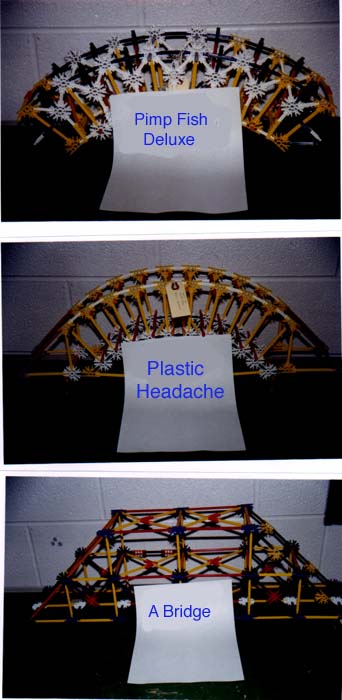
The United States will need a scientifically and technologically literate
citizenry to cope with the accelerating pace of change and to set appropriate
educational, industrial, and national priorities. Only an educated public
can evaluate competing claims about risk and benefit and make reasonable choices
and decisions about technical issues, whether it is to fund research at the
national level or to evaluate the credibility of evidence presented in a court
of law. However, most students in Universities do not choose to major in science-
or technology-related fields. At the University of Rochester, 72% of undergraduates
major in the Humanities and Social Sciences.
Many institutions have attempted to introduce non-science majors to the ways
in which science and technology function. These science courses for non-majors
are usually based on one of two schemes. One is "show them everything", and
the other is "show them what they think they need."
The "show them everything" scheme attempts to show students everything about
a field of science in one or possibly two semesters. For example, a non-major
taking a physics course is bombarded in one semester with Classical Mechanics,
Electricity and Magnetism, Relativity, and Quantum Mechanics, all without
significant mathematics. The claim is that students appreciate the scientific
method and the beauty of science even if they cannot do science by the end
of the course. However, it is impossible for any student to sort out the amount
of information presented in a one-semester of "Show them everything" course.
Even science majors take many semesters to make sense of it all, and they
are motivated to pursue the area even in the face of confusion. The non-major
never has the time to sort out the mass of material and have it make sense.
The "show them what they think they need" approach usually offers courses
that are tightly focused on topics of interest to students. "Physics of hi-fi,"
"Chemistry in the Environment," or other topical courses are examples of this
approach. In such courses, students only see smatterings of extremely complicated
topics that are still debated among experts, and so are left with minimal
understanding of the material. In both approaches, students achieve at best
a declarative knowledge of the field rather than a functional one. They might
be able to state isolated facts, but are not able to use the underlying theories
to form new theories or to evaluate a new strategy as opposed to an old one.
To improve the quality of the undergraduate education outside the major, the
University of Rochester recently adopted a new requirement that all undergraduates
must engage in three areas of focused study: one each in Humanities, Social
Science, and Natural Science / Engineering / Mathematics. One area of focus
will be the student's major, and students must elect a Cluster of three related
courses in each of the two divisions outside the major. They must earn a C
average in each cluster. Students of Engineering, because of the already strict
requirements of the ABET-accredited curricula, will have to complete only
one Cluster in Humanities or Social Science, and are required to take another
two courses in those areas by their Departments.
This new curriculum requires every Humanities and Social Science major to
take at least three related courses in the Natural Science / Engineering /
Mathematics area. It presented the University with an opportunity to significantly
revise and improve the experience of non-majors and to change the way the
sciences, engineering, and mathematics are taught to non-science majors. A
request for proposals from the National Science Foundation aimed at institution-wide
reform of undergraduate science education brought together a cross-disciplinary
group of Natural Science / Engineering / Mathematics faculty to explore the
development of a new cluster of science courses. Our proposal to develop a
new cluster of science courses was accepted by the National Science foundation,
and funding was approved in 1997.
This report summarizes the work we have carried out as part of this program
and the impact that funding of this project has had on the undergraduate education
at the University of Rochester. In Section II the courses that were developed
as part of this program are described. A summary of the assessment of our
efforts is provided in Section III. The general impact of this project on
undergraduate education at the University of Rochester is described in Section
IV. Our conclusions are summarized in Section V.
The courses that were developed as part of this program apply an inquiry-based
approach, which exposes students to the scientific method. These courses address
the larger view of science by exploring what constitutes a scientific theory,
by providing students with the opportunity to engage in scientific hypothesis
testing in the laboratory, and by examining the writings of scientists and
their humanist contemporaries about the worldview that science provides. Rather
than "show and tell," the courses focus on the process of discovery. This
process is not only used to teach the basic principles of science, but also
studies science from a historical perspective (Several major scientific concepts
that provided radical challenges to accepted world views at the time they
were proposed are used to illustrate the operation of the scientific method).
The students are also exposed to the design process, specifically the process
of determining the constraints and the optimization of the design. This is
a topic to which even science majors are usually not exposed, but which clearly
affects everyday life.
The courses that were developed as part of this program are described in the
remainder of this Section.
IIa. Life's Devices: Mechanical design in biological & man-made
structures
The course "Life's Devices: Mechanical design in biological & man-made
structures" was developed by Professors Renato Perucchio and John Lambropoulos
in the Department of Mechanical Engineering at the University of Rochester.
The course was first taught in Fall 1997, and has been taught each fall since
then. The course is aimed at students, mostly freshmen or sophomores, having
an interest in technology in general but not necessarily majoring in engineering.
It is clear to many faculty and educators that a scientifically literate society
must be able to address and evaluate rationally the products of its technology,
from nail-clippers to the space shuttle. Science becomes technology, and technology
produces the devices of every-day life through the process of design. Design
is a fundamental part of all engineering curricula, and is currently often
taught as a capstone course after the students have completed the entire math,
physics, and engineering analysis courses. The goal of this course is to educate
non-engineering students at UR about the process of design. What are the design
constraints, how are these constraints implemented, which issues arise when
designing a product, how are these issues resolved, and is creativity perhaps
more important than technical expertise in successful design of products?
Design is an open-ended, creative process in which there is no unique solution
to a design problem. In fact, there may be many “correct” solutions,
all of which may meet the design constraints. This is in contrast to the often
held belief by non-science majors that in science there is always a single
correct solution.

Figure 1. Examples of different designs of a truss bridge created by students enrolled in ME104Q, Life’s Devices.
The fundamental technical content that the students learn in this course
are the concepts of force and power, and how engineering structures are used
to transmit these. In addition to this, the course focuses on other issues
that the design process must address, such as economics, ethics, aesthetics,
safety, and legal issues, and how these effects are evaluated when making
design decisions and are implemented in the design of common appliances used
in every-day life.
To motivate the students from the very beginning, design is discussed in the
context of two areas in which all students have a very good intuitive understanding:
the human and animal bodies, and man-made structures which humankind has been
using over the centuries. To study the mechanical design of human-made structures,
the students start by looking at simple devices used in antiquity for transmitting
force and power for peaceful and war-like purposes such as water wheels, war
ships, bows and arrows, aqueducts, domes, and buildings. The students then
discuss the design process by examining common utensils, and discussing how
design choices are made among different materials, functions, etc. When the
students examine biological design, they discover how the size and function
of many living biological structures is related to their mechanical design
for the transmission of force and power, and how the mechanical design of
“small” organisms is fundamentally different from the design of
“large” ones, although the physical principles are exactly the
same in both cases. In this part of the course, the students also focus on
the process of measurement, and how one can make excellent approximations
of the dimensions of these biological structures by the process of estimation.
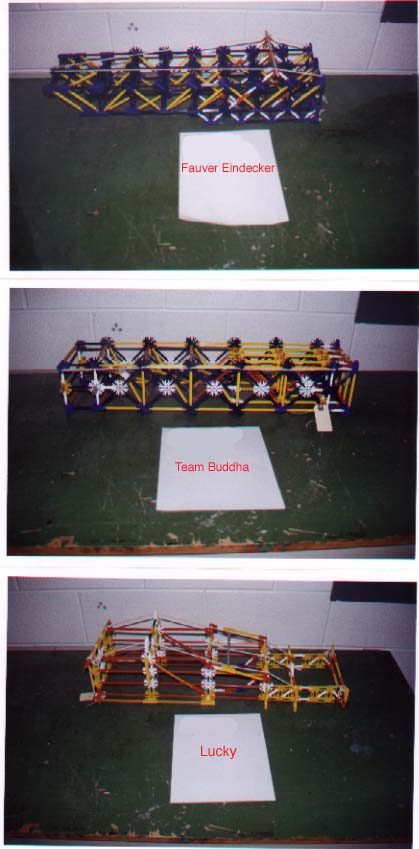
Figure 2. Examples of different designs of an aircraft wing created by students enrolled in ME104Q, Life’s Devices.
The students have to hand in design projects and reports from the very beginning
of the course. Students are reqired to work in teams of two to three students
in order to emphasize the value of coordination, exchange of ideas, and brainstorming.
Each team is given a construction kit, consisting of about 1000 plastic Kinex
pieces, for the design of three-dimensional structures such as towers, bridges,
and domes. Kinex pieces are used, rather than for example balsa wood and glue,
since Kinex hinges and beams all have equal strength. As a result, the success
of each student team is not based on their dexterity in using glue, but rather
on their skills conceiving and executing geometrical structural design in
two and three dimensions. The Kinex beams and hinges can be very quickly snapped
in and out of position, allowing many different designs to be explored in
a short period of time. During the semester the following 7 projects are carried
out:
For each project, each team hands in one agreed upon design solution. In
addition, each student of the team is required to hand in a separate design
report, which describes in detail the design process and the final design
solution. Each design is tested to ensure it meets the design goals. Examples
of different designs of a truss bridge are shown in Figure 1. Figure 2 shows
examples of different designs of an aircraft wing.
IIb. Physics by Inquiry
The Physics by Inquiry course was developed by Professor Frank Wolfs
of the Department of Physics and Astronomy. The goal of Physics by Inquiry
is to provide the students with direct experience in the process of science.
The design of this course was based on the belief that science can not be
learned by reading, listening, memorizing and problem solving, but requires
active mental engagement. Although most science courses for science majors
are supplemented with required labs, even in those courses active engagement
is rather limited. In most of our current science courses for non-science
majors, the laboratory component is missing, and these courses often fail
to provide the students with a scientific intuition and an appreciation for
the scientific process.
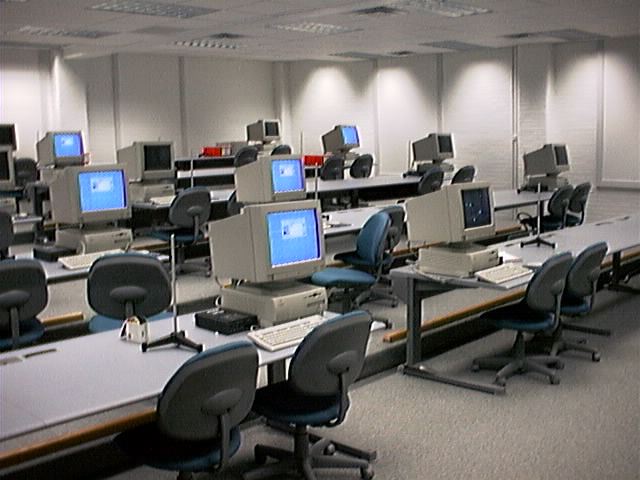
Figure 3. Picture of the computerized classroom (B&L 407) constructed for the Physics by Inquiry course.
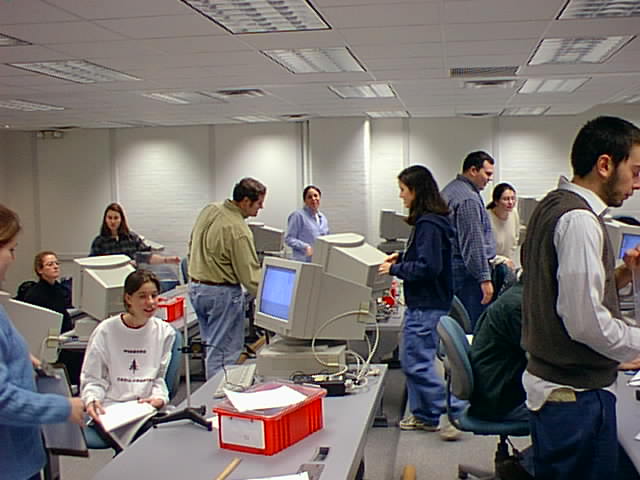
Figure 4. Physics by Inquiry students hard at work in B&L 407.
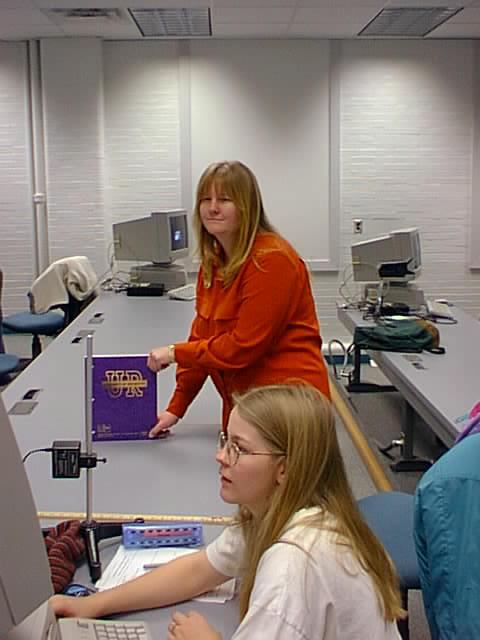
Figure 5. Physics by Inquiry students hard a work in B&L 407, trying to carry out a motion in front of a motion sensor that is shown on a graph on their computer screen.
Physics by Inquiry focuses on the scientific method. The students
start from their own observations, develop basic scientific concepts, use
and interpret different forms of scientific representations, and construct
explanatory models with predictive capabilities. The students develop scientific
reasoning skills and gain experience in relating scientific concepts, representations,
and models to real-world phenomena. By providing a direct exposure to the
scientific process, we hope to provide the students with a solid foundation
for scientific literacy. Topics that are covered in this course are physics
and astronomy.
To achieve the goal of active involvement, the course is taught in a computer-equipped
classroom in which each student (or pair of students) has access to a computer
and is able to carry out data analysis during lectures. Simple experiments
are carried out by each student individually. More sophisticated experiments
are carried out by the instructor, and the data collected are available to
each student via the network. For example, complicated two-dimensional motion
is videotaped and digitized for immediate analysis by the students.
The funds for the construction of the computer equipment for the computerized
classroom were provided by the University. Figure 3 shows a photograph of
the classroom (B&L 407) in the Department of Physics and Astronomy, which
was constructed for the Physics by Inquiry course. Figures 4 and 5
show pictures of some of the Physics by Inquiry students at work during
the “lecture” period. Most of the “lecture” period
is devoted to hands-on experiments, which focus on various aspects of the
scientific method. The students shown in Figures 4 and 5 are working on an
experiment in which they are asked to carry out a motion in front of a motion
sensor that describes the curve shown on their computer screen. This experiment
is used to gain experience with scientific graphics, and with graphing motion
in particular.
Some of the experiments carried out by the Physics by Inquiry students
were carried out outside the classroom. Examples, include the following:
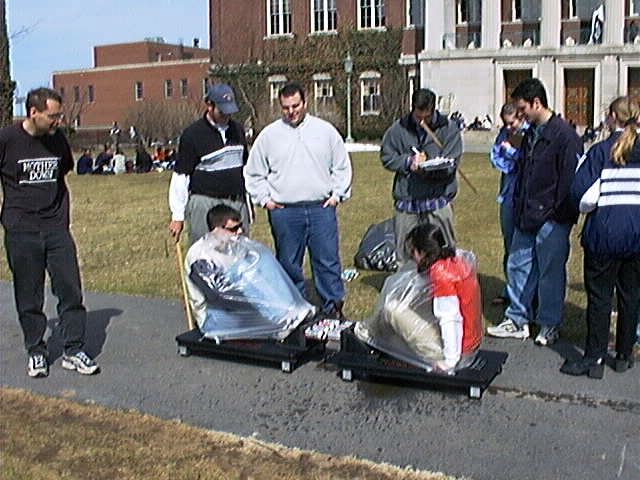 |
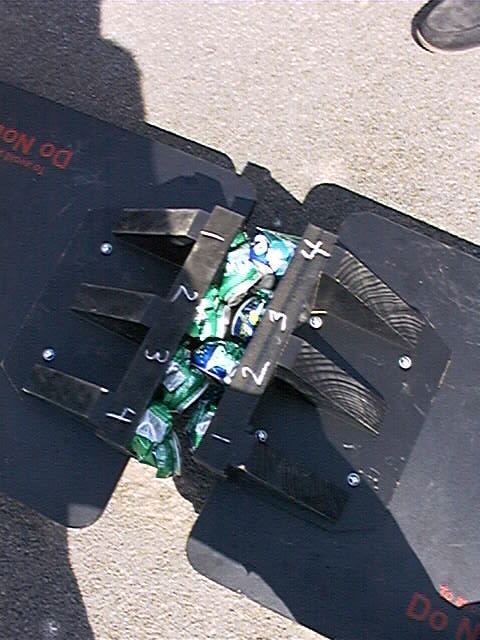 |
|
Figure 6. Inelastic collision between 2 Physics by Inquiry teaching
assistants, using full soda cans as bumpers.
|
Figure 7. Results of an inelastic collision between two Physics by
Inquiry students. The deformation of each can was measured in order
to determine the correlation between deformation and loss of kinetic
energy.
|
In the current academic year, Physics by Inquiry will be taught for the fourth
time. Several new innovations were made during the summer and it is hoped
that the experience gained with this inquiry-based approach to teaching can
also be applied in a number of undergraduate courses for science majors.
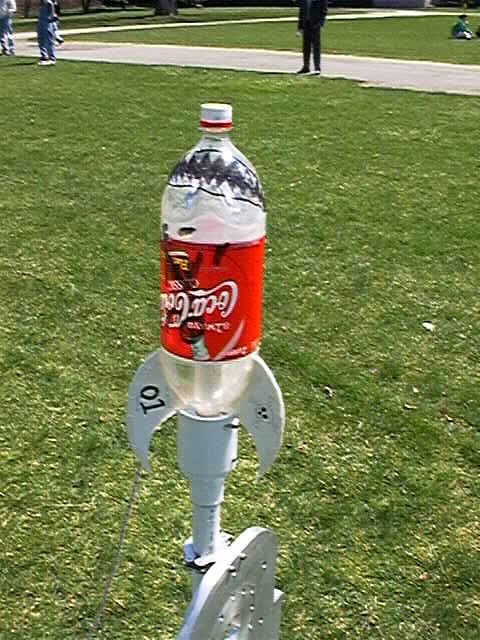 |
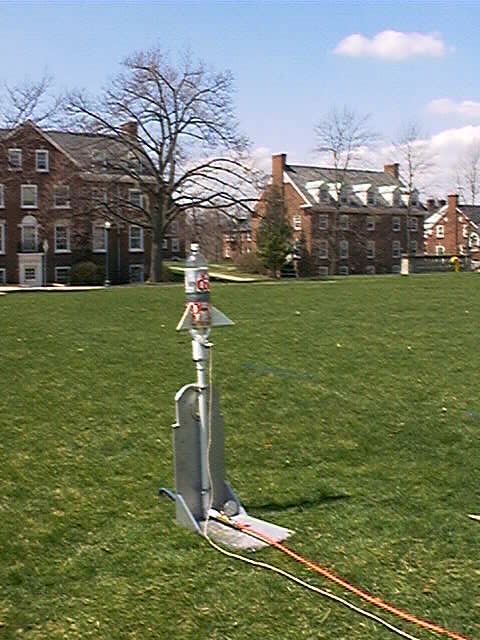 |
|
Figure 8. The best performing Physics by Inquiry rocket.
|
Figure 9. One of the many other rockets designed and build by the Physics
by Inquiry students.
|
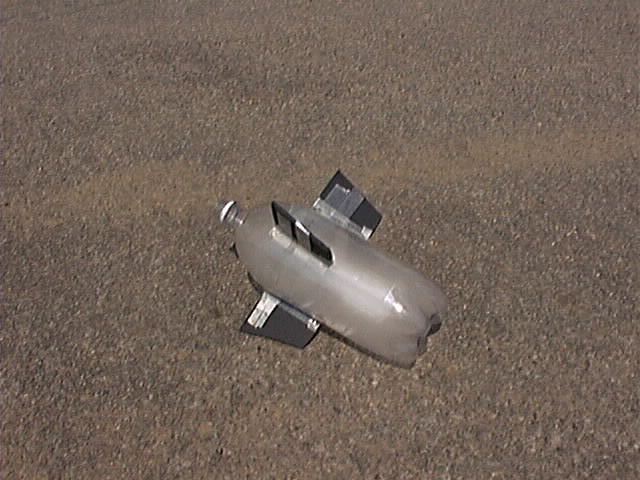 |
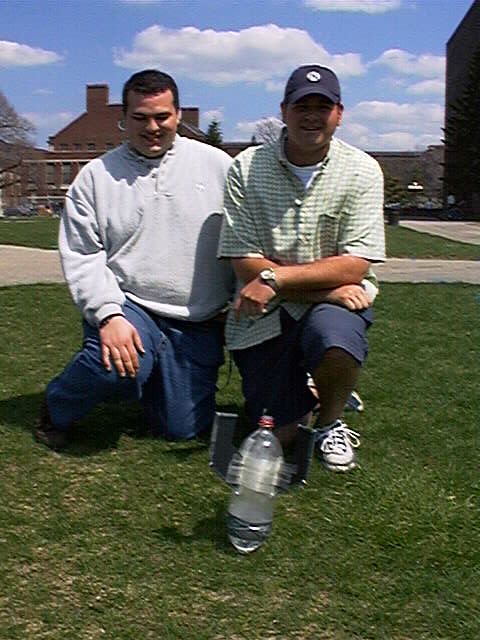 |
|
Figure 10. Physics by Inquiry rocket survives a hard landing.
|
Figure 11. Two Physics by Inquiry students admire the way their
rocket landed after reaching a height of 200 ft.
|
IIc. Clockwork to Chaos
The Clockwork to Chaos course was developed by Prof. Ian Walmsley of
the Institute of Optics and by Professor Daniel Albright
of the Department of English, and is taught jointly by them. The intent of
the course is to show the connectivity of knowledge across the broad spectrum
of academic disciplines, from the purely symbolic to the completely representational,
by introducing some of the major developments in physics, chemistry and biology
that have shaped our world view, and how the consequences of that world view
have been explored in literature, art and music. As an example, the ideas
developed by Leibniz as the calculus of variations are illustrated in specific
form by deriving Snell’s Law of Refraction from Fermat’s Principle.
Leibniz’ exaltation of minimization schemes to the level of a teleology
--the mathematical, and therefore logical, extension of Occam’s Razor
-- are explored in the writings of Voltaire, particularly in Candide,
and the untenable position of extending a physical or mathematical theory
beyond its domain of validity is exposed.
The central themes of the course, which relies heavily on participation of
the students via in-class discussions, are explored by extensive reading in
both introductory science books (and in non-mathematical articles by the scientists
who discovered some of the major ideas) and in literature. The students are
evaluated by the preparation and execution of three projects and an essay,
for each of which they develop a particular theme to greater depth, and which
may encompass any area of human enquiry. Some examples are indicated by the
presentation titles: The reversibility of time in physical equations, and
Borges “A New Refutation of Time”; Ptolemy’s epicycles,
Fourier’s series and Ligeti’s tone poems: stochastic vs. regular
time series; The futurist machine-music of Prokofiev, Russolo, Antheil and
Mosolov: noise, technology and art. It is important to realize that the construction
of these presentations requires extensive research on the part of the students,
as well as a sorting of ideas -- in importance, chronology and logical sequence
-- and therefore helps them to develop critical thinking outside the boundaries
of a specific discipline, honing skills that are broadly applicable.
Students enrolled in this course will explore how scientists develop models,
including the balance of inductive and deductive reasoning inherent in the
classical scientific method, the nature of physical law and falsifiability,
the grand ideas of physics (and some of chemistry and biology) from Newtonian
mechanics to the nonlocality of quantum wavefunctions, and the notion that
creative genius (similar in character to genius as conceived in the humanities
-- a perceiving of hidden relationships between remote areas of experience)
is required to develop an insight that leads to new understanding. The students
will realize that humanists also explore the world by asking “What if?”
and develop consequences in response to this question, that poetry is also
about categorizing our existence, and that elegance, economy and beauty are
apparent in all forms of knowledge.
Beyond this, it is hoped hope that students will leave the course with a deeper
insight into what the University is about, that connections will be made across
quite disparate fields, and the undertakings of both scientists and humanists
will not appear so very different in some respects, even if the topics they
are studying are quite different.
The effectiveness of the inquiry-based and problem-solving format of our
courses was evaluated throughout each semester and at the conclusion of each
term. Additional assessment was conducted at subsequent times, allowing students
and faculty to reflect upon their experiences from a later perspective.
During the implementation of these courses, the conceptual development of
students was assessed continuously by virtue of the interactive and hands-on
nature of these course activities.
At the end of each semester, the Student Course Opinion Questionnaire was
administered. This instrument, available to all instructors in the College,
asks students to give their opinions about their own active participation
and about the effectiveness of the course and the instructor. This instrument
revealed the students’ general endorsement of these courses, as in the
following rankings:
Life’s Devices Overall course rating (5 pt scale, 5 = highest rating)
1997 1998 1999
mean 4.11 4.57 4.33
Overall instructor rating (5 pt scale, 5 = highest rating)
1997 1998 1999
mean 4.78 4.86 4.89
Physics by Inquiry Overall course rating (5 pt scale, 5 = highest rating)
1998 1999 2000
mean 4.17 4.25 3.22
Overall instructor rating (5 pt scale, 5 = highest rating)
1998 1999 2000
mean 4.50 4.58 4.11
Clockwork to Chaos Overall course rating (5 pt scale, 5 = highest rating)
1996 1998 2000
mean 4.55 4.21 4.27
Overall instructor rating (5 pt scale, 5 = highest rating)
1996 1998 2000
mean 4.73 4.71 4.27
To augment these numerical rankings, more extensive information about students’
experiences was solicited by several methods. For example, students in Frank
Wolfs’ Physics by Inquiry course wrote essays at the conclusion
of the semester about their participation in this course. Students noted general
enthusiasm for this hands-on method of physics learning and made observations
about very specific experiences. Since this course began with instruction
in how to calibrate instruments, several students outlined their acquisition
of the scientific thinking that necessitates such a thoughtful, methodical
approach to understanding measurement. Some students described their initial
confusion about the equipment and the experiments and asked for more help
with these technical concerns:
I would also suggest that the first few class periods of the class be solely
devoted to getting to know the computers and how the software works. Many
times I understood concepts yet the computer problems got in the way.
Another student noted:
The lab was a new environment, very different from my lab experiences in
high school and I repeatedly asked myself, what are these people asking me
to do? I had never seen a motion sensor before and the fact that it needed
to be calibrated before I used it was a completely new concept to me.
Later they came to understand the goals and the process of experimentation:
The class started with the most fundamental of experimental processes by
calibrating the systems used to measure the experiments we would be conducting.
This taught the student when, how, and where to rely on the equipment so essential
to obtaining experimental data. At first, this did not appear to help
my physics knowledge, but by the end of the course a student becomes so dependent
upon the systems that help him or her understand physics that the equipment
actually represents the student’s first line of analytical ability.
Another student described how this careful thinking about instrumentation
early in the course continued to help her learn later throughout the semester:
I remember we started the semester off with measuring the bounds of the
motion detector. We decided that it could not produce an accurate reading
at less than .4 m and that the further away we got from the sensor, the more
likely we were to have it bounce off of other objects and produce incorrect
measurements. The day or two that we spent on that calibration exercise stuck
with us the entire semester. When we were in the very last week or two, we
had to use the motion sensor to find a line of best fit, from which the slope
equals velocity. A concept I learned along the way. Later in this lab, the
motion sensor was on the floor, and a mass was hanging from a spring off the
lab top. After [another student’s] and my first run, we had a beautiful
oscillation graph, but at the bottom, the motion went unregistered. After
pondering it a minute or two, we both remembered the .4 m rule. Again, we
were able to take information learned at the very beginning of the semester,
and apply it to much more involved experiments.
Other students expressed their appreciation for the access to this level of
experimentation:
Physics 105 exposed me to many pieces of equipment such as: Science Workshop
Interface, a 1.22 meter track, a dynamics cart, Smart Pulley, PASCO motion
sensor, force sensor, magnetic bumpers, just to name a few. More importantly,
this class gives non-science students the opportunity to experience science
research. We, students never slept through a class because we were constantly
doing another experiment, which allowed us to physically see the principles
and laws in action.
They learned how to regard data. One student noted:
My most priceless instruction followed a very unscientific behavior of
disregarding data that did not fit my predictions, or theory. Disregarding
data obtained through a valid experimental process is unacceptable. Certainly,
very serious conditions must be met before one can engage in this type of
activity.
Another Physics by Inquiry student made a similar comment about data
analysis:
This brings me to the one thing that I never could have learned in any
other class quite so well. NEVER MESS WITH YOUR DATA!!!!! I think if there
is one thing we all learned, it is that you can't throw away your data just
because it does not fit other pieces of data. Further, we learned ways in
which we can reason through our weird calculations and results.
Students in the Clockwork to Chaos course were asked to add written
comments to the Student Course Opinion Questionnaire. A common concern related
to the extensive scope of the material within very limited time. In response
to the question, “What are the major weaknesses of the course,”
a number of students responded with comments like the following:
Lack of time. The designated period goes by very fast, perhaps expanding
it to 2 semesters would be wise.
So much material, so little time. We weren’t able to cover a large
portion of the subjects on the syllabus.
I’d have liked to go more in depth on certain books and not move
so quickly past so many—especially the shorter poems and stories.
When asked about the strengths of the course, Clockwork to Chaos students
strongly endorsed the opportunity to combine the two perspectives of science
and the humanities:
The combination of one literature-oriented mind and one science-oriented
mind was enriching for our class discussions. I found myself stimulated from
each and every lecture. I would take this course again in a second.
It [the course] truly does give the students a chance to think. Instead
of just learning about literature and science as separate entities, we get
to integrate them. It’s amazing how much one lives within the other,
and how each changes and processes through the development of the other as
well.
Faculty reflected upon their experiences in these courses as well. John Lambropoulos
and Renato Perucchio emphasized that the Life’s Design has been
intended to serve as an opportunity for non-science students to learn about
the process of design:
Design is a fundamental part of all engineering curricula, and is currently
often taught as a capstone course after the students have completed the entire
math, physics, and engineering analysis courses. Our goal in teaching our
Quest course is to educate non-engineering students at UR about the process
of design. What are design constraints, how these constraints are implemented,
the issues which arise when designing a product, how these issues are resolved,
and how creativity is perhaps more important than technical expertise in successful
design of products.
Design is an open-ended, creative process in which there is no unique,
correct solution to a design problem. Rather, there may be many “correct”
solutions, all of which may meet the design constraints. Part of our course
goals is to show to non-science majors taking our course that, contrary to
the often held belief that in science there is always a correct solution,
the design process is open-ended and may admit of many correct solutions.
During the Spring Semester 2000, Dean of Freshmen, Dale McAdam, collected
faculty and student opinions for a report on Quest and Quest-like courses,
which included the courses developed as part of this project. Quest courses,
are designed principally for first-year and some second-year students, are
small, problem-centered courses that employ a research-based pedagogy and
introduce students to the distinctive nature of college learning. The
goals of Quest courses are very similar to the goals we developed for our
courses, except that most Quest courses try to attract students majoring in
the course discipline, while our development focusing on the non-majors. Nevertheless,
the report provided valuable feedback about the success of the research/inquiry-based
pedagogy. The faculty reflected on the concentration and skill required to
guide students in these high-intensity courses:
Quest teaching is full contact teaching. .I must admit that the idea of
waiting in silence for a student to summon the courage to take a stab at an
answer, and then having to think quickly to make use of that answer and connect
it to broader themes of the course is a new tactic for me, and a powerful
one. (Ian Walmsley)
Socrates was right: Learning of the most intense kind takes place through
dialogue. (Daniel Albright)
Dean McAdam found that students emphasized their appreciation for real interaction
with faculty:
We were allowed to talk “out of bounds” as opposed to recycling
information recited to us in a lecture hall.
Quest courses allow students and faculty to develop good working relationships
earlier in the college experience, making them more beneficial for both parties.
McAdam notes that students choose these courses because “they match
their interests, not because they meet college requirements.”
Another opportunity to evaluate the effectiveness of this course format was
afforded by Lynn Donahue, who recently completed her dissertation for the
University of Rochester’s Margaret Warner Graduate School of Education
and Human Development. The subject of her dissertation, entitled “Students’
Perceptions as Experiential Learners in Courses Defined as Experiential,”
included an art class and Frank Wolf’s Physics by Inquiry course.
She found that students perceived their learning in these courses as “engaging,
reflective, and self-reliant, and relevant.” She particularly noted
the importance of what she termed “catalytic events” that propelled
students toward more active learning and the need for students to connect
classroom learning with their own personal systems of meaning making.
The courses that were developed as part of this project are highly successful.
A total of 161 students have taken these courses since they were first offered.
Details about the student enrollment in our courses are provided in Table
1.
All students enrolled in Physics by Inquiry are non-science majors
while the students enrolled in Life’s Devices and Clockwork
to Chaos come from the science and non-science divisions. Most non-science
students enrolled in our courses take our courses to satisfy their Cluster
requirements. Details on the number of students enrolled in clusters of which
our courses are part are listed in Table 2.
The enrollment in our courses is limited to 20 – 40 students in order
to ensure optimum interaction between faculty and students, and to ensure
the creation of a small group environment. In addition, resource limitations
also required us to limit the enrollment.
Although the courses we developed have a significant impact on the education
of our non-science majors, the overall project has had a much broader impact
on the undergraduate education for both our science and our non-science majors.
Some specific examples of the impact are:
|
Course
|
Semester
|
Number of
Students
|
Life’s Devices |
Fall 1997
|
13
|
|
|
Fall 1998
|
7
|
|
|
Fall 1999
|
10
|
|
|
Fall 2000
|
31
|
|
|
|
|
Physics by Inquiry |
Spring 1998
|
12
|
|
|
Spring 1999
|
13
|
|
|
Spring 2000
|
13
|
|
|
Spring 2001
|
19
|
|
|
|
|
Clockwork to Chaos |
Fall 1996
|
13
|
|
|
Spring 1998
|
15
|
|
|
Spring 2000
|
15
|
Table 1. Student enrollment in the courses developed as part of this project.
|
Cluster
|
Number of
Students
|
|
An Introduction to the Physical
World
|
16
|
|
Quantitative Physics
|
16
|
|
Science -- Discovery, History and
Methodology
|
42
|
|
The Nature of the Universe
|
66
|
|
Introduction to Physical
Science
|
15
|
|
Science and Technology by
Inquiry
|
1
|
|
The Scientific Method
|
2
|
|
Biomechanics
|
0
|
|
Biomedical Engineering
|
0
|
|
Design with Materials
|
0
|
|
Engineering Design
|
0
|
|
Literature, Science and
Technology
|
0
|
Table 2. Details about cluster enrollment in clusters of which Life’s
Devices, Physics by Inquiry, and Clockwork to Chaos are
part.
The faculty involved in this project have come to realize that with new approaches
to learning, new tools must be developed to evaluate the impact of the changes
we make on the learning process of the students. The change in thought process
about goals and assessment has forced us to better define our course goals,
not only for the courses developed as part of this project, but also for the
other courses we teach. The change in our thought process was also shared
with other faculty during a workshop organized in the 1999 – 2000 academic
year that focused on assessment.
The funds provided by the National Science Foundation have provided us with
the tools to start reform of our undergraduate education. The success of our
initiative, will have a long lasting effect on how we think about teaching.
The tools and techniques developed as part of this program, and the stories
of its success, will provide the incentive to others in the College to implement
our approach to learning in many other courses, both for science and for non-science
majors. Although the number of students enrolled in each course will never
be large, the increase in the number of courses that use the inquiry-based
approach will ensure that a large fraction of the students studying at the
University of Rochester will encounter several inquiry-based courses during
their stay in Rochester.
© Frank L. H. Wolfs, University of Rochester, Rochester, NY 14627, USA
Last updated on Saturday, February 17, 2001 10:26